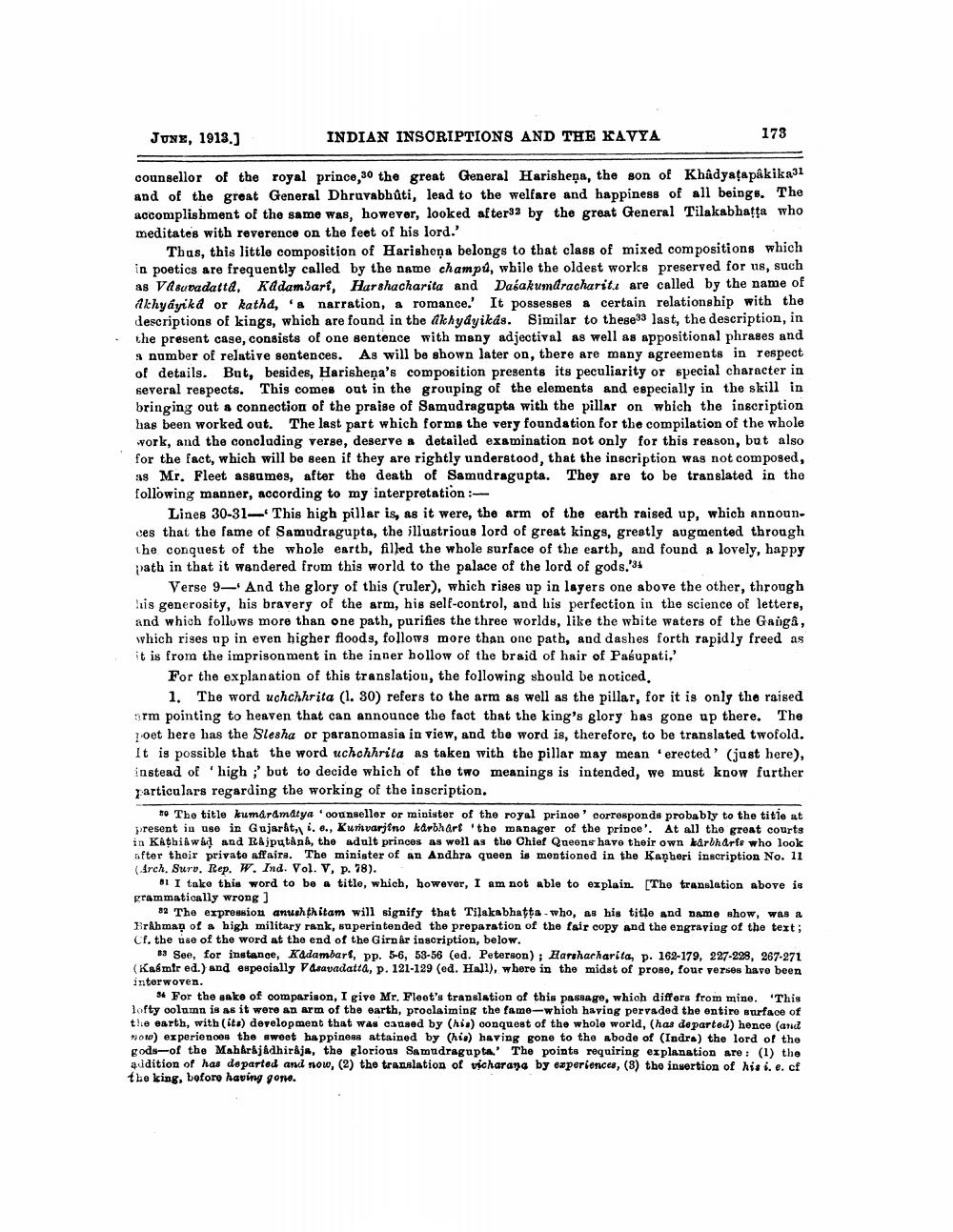________________
June, 1918.)
INDIAN INSORIPTIONS AND THE KAVYA
173
counsellor of the royal prince, 30 the great General Harisheņa, the son of Khadyaţa pâkika31 and of the great General Dhruvabhati, lead to the welfare and happiness of all beings. The accomplishment of the same was, however, looked after32 by the great General Tilakabhatta who meditates with reverence on the feet of his lord.'
Thus, this little composition of Harisheņa belongs to that class of mixed compositions which in poetics are frequently called by the name champú, while the oldest works preserved for us, such as Vakuvadatta, Kadamdari, Harshacharita and Dabakumdracharits are called by the name of Akhyāyikd or katha, 's narration, a romance. It possesses a certain relationship with the descriptions of kings, which are found in the akhyáyikas. Similar to these 33 last, the description, in the present case, consists of one sentence with many adjectival as well as appositional phrases and s number of relative sentences. As will be shown later on, there are many agreements in respect of details. But, besides, Harishena's composition presents its peculiarity or special character in several respects. This comes out in the grouping of the elements and especially in the skill in bringing out a connection of the praise of Samudragapta with the pillar on which the inscription has been worked out. The last part which forms the very foundation for the compilation of the whole work, and the concluding verse, deserve a detailed examination not only for this reason, but also for the fact, which will be seen if they are rightly understood, that the inscription was not composed, as Mr. Fleet assumes, after the death of Samudragupta. They are to be translated in the following manner, according to my interpretation :
Lines 30-31— This high pillar is, as it were, the arm of the earth raised up, which announces that the fame of Samudragupta, the illustrious lord of great kings, greatly augmented through the conquest of the whole earth, filled the whole surface of the earth, and found a lovely, happy path in that it wondered from this world to the palace of the lord of gods. 36
Verse 9- And the glory of this (ruler), which rises up in layers one above the other, through huis generosity, his bravery of the arm, his self-control, and his perfection in the science of letters, and which follows more than one path, purifies the three worlds, like the white waters of the Ganga, which rises up in even higher floods, follows more than one path, and dashes forth rapidly freed as it is from the imprisonment in the inner hollow of the braid of hair of Pasupati,
For the explanation of this translation, the following should be noticed
1. The word uchchhrita (1. 30) refers to the arm as well as the pillar, for it is only the raised orm pointing to heaven that can announce the fact that the king's glory has gone up there. The roet here has the Slesha or paranomasia in view, and the word is, therefore, to be translated twofold. It is possible that the word uchchhrita as taken with the pillar may mean erected' (just here), instead of high ;' but to decide which of the two meanings is intended, we must know further particulars regarding the working of the inscription.
The title kumaramdtya .counsellor or minister of the royal prince' corresponds probably to the title at Dresent in use in Gujarat, i. o., Kumvarjeno karbhart the manager of the prince'. At all the great courts in Kathiaw and Rajputana, the adult princes as well as the Chief Queens have their own karbharfe who look after their private affairs. The minister of an Andhra queen is mentioned in the Kanberi inscription No. 11 (Arch. Surv. Rep. W. Ind. Vol. V, p. 78).
di I take this word to be a title, which, however, I am not able to explain. [The translation above is grammatically wrong )
82 The expression anushthitam will signify that Tilakabhatta - who, as his title and name show, was a HrAhmaņ of a high military rank, superintended the preparation of the fair copy and the engraving of the text; Cf. the use of the word at the end of the Girnår inscription, below.
13 See, for instance, Kadambarf, pp. 5-6, 58-56 (ed. Peterson); Harshacharita, p. 162-179, 227-228, 267-271 (Kasmir ed.) and especially Vasavadatta, p. 121-129 (ed. Hall), where in the midst of proso, four verses have been interwoven.
84 For the sake of comparison, I give Mr. Fleet's translation of this passage, which differs from mine. This lofty column is as it were an arm of the earth, proclaiming the fame-which having pervaded the entire surface of the earth, with (ita) development that was caused by (his) conquest of the whole world, (has departel) hence (and now) experiences the sweet happiness attained by (his) having gone to the abode of (Indra) the lord of the gods-of the Maharajadhiraja, the glorious Samudragupta.' The points requiring explanation are: (1) the addition of has departed and now, (2) the translation of vicharaya by experiences, (3) the insertion of his i. e. cf the king, before having gone.




